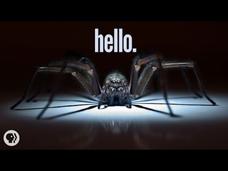Science360
AI-powered software identifies voices in noisy environments
Imagine being able to hear a voice with extreme clarity even in the loudest environment. Yobe Inc., a small business funded by the National Science Foundation (NSF), is developing speech recognition and voice authentication software that...
Curated Video
Data Science and Machine Learning with R - Single Variable Plots
This video focuses on single variable plots. This clip is from the chapter "Data Visualization in R" of the series "Data Science and Machine Learning with R from A-Z Course [Updated for 2021]".This section explains data visualization in R.
Vlogbrothers
This is the scariest graph I've ever seen
Graphs shouldn't be scary! They're just data! And even though I have a masters degree in environmental studies, this graph, once it was explained to me, changed how I felt about the impacts we were having on the planet completely. Of...
Curated Video
Design a computer system using tree search and reinforcement learning algorithms : Creating an Agent to Solve the MAB Problem Using Python and Tensorflow
From the section: The Multi-Armed Bandit. In this section, we will learn about the basics and look at one of the most foundational concepts in Reinforcement Learning – The Multi-Armed Bandit We construct a model of a MAB environment from...
FuseSchool
What is Homeostasis?
So what is homeostasis is a term first defined by Claude Bernard in 1865 it means maintaining a constant internal environment this is a bit like car brain works senses all around the body imaging various things and sending the...
Bozeman Science
Environmental Economics
In this video Paul Andersen explains how economic models, like supply and demand, can be applied to environmental systems. The market forces will not protect environmental services until proper valuation and externalities are...
MinuteEarth
The Great Acceleration
We’re in the middle of a rapid, unprecedented, and world-changing increase in the intensity and scale of human activity on this planet.
SciShow
SciShow Psych Talk Show: Kati Morton
Welcome to the very first episode of SciShow Psych Talk Show! Hank talks with Kati Morton about mental health: from how you find a therapist to toxic relationships.
Vlogbrothers
Uncomfortable Nuance: Natural Gas Edition
I almost titled this video "Is fracking good?" but I decided not to do that because, like, obviously, no. Anything that increases the amount of fossil fuels we can get out of the ground is bad. But, at the same time, natural gas is used...
California Academy of Science
What is the Environmental Impact of Feeding the World?
One in every seven people suffer from a lack of basic food. Our Hungry Planet introduces this complex issue in the second lesson of an interesting 13-part unit. It discusses the space needed to grow and raise food, the transportation of...
Curated OER
Biotic and Abiotic Factors
Life is complex. Just a slight change in the population of one species will have a substantial change on the biotic and abiotic factors of that species' environment. In this video, Mr. Andersen explains the effects removing wolves from...
Curated OER
Biodiversity
Jaguars feed on 87 different species, making it a keystone species. What happens when such a critical link of the food chain goes missing? Mr. Andersen identifies different keystone species according to ecosystem, and he explains the...
SciShow
How Studying Venus Saved Earth
Scientists discovered a hole in the ozone layer in 1980, and by 2000, the hole was three times the size of the United States. Through global efforts, scientists discovered the cause and worked together to get countries to implement a...
Teacher's Pet
Types of Natural Selection
Natural selection—good things come to those who mate. The video introduces the idea of natural selection. Then it details three types: directional, stabilizing, and disruptive. It includes both graphs and examples for each type.
Be Smart
How Many Species Are There?
Scientists discover over 15,000 new species each year. Despite studying life on our planet for all of human history, we still don't know how many species exist on Earth. An informative video from a biology playlist presents the dilemma,...
Veritasium
13 Misconceptions About Global Warming
With so much information floating around about global warming, how can we tell what's really going on? Examine the evidence through a video from Veritasium to sift through everything we hear. The narrator presents convincing data when...
Be Smart
Why I'm Scared of Spiders
Eighty-four percent of people have an irrational fear. This video focuses on a fear of spiders. It explains the different types of fear, the conditioning that creates fear, and the evolutionary advantage to these fears. It doesn't just...
PBS
That Time Oxygen Almost Killed Everything
Oxygen keeps us alive, but did you ever consider how Earth found the right balance? Eons produced this video as part of a larger series that explores when Earth contained very little oxygen and green oceans ruled the planet. Viewers see...
California Academy of Science
Bugs for Breakfast
More people in the world eat bugs as a source of protein than the number of people who don't eat bugs. Viewers consider bugs as a food source to solve multiple issues. Our Hungry Planet introduces bug-based food as a possible solution to...
Be Smart
Is Height All in Our Genes?
Humans on average are shorter than they were centuries ago. Young scholars analyze the factors that affect the height of individuals including historical trends in a video lesson. The presentation analyzes both genetic and...
California Academy of Science
Your Digital Footprint: Data and Energy Use
Understanding energy usage requires knowing more than how much energy it takes to charge your cell phone. Scholars learn each text sent uses energy as does each video, game, and phone call. They observe the larger grid of data transfers...
California Academy of Science
Coral Reefs and Climate Change
Coral reefs cover less than one percent of the ocean floor, yet more than 25 percent of marine life lives in coral reefs. A colorful, engaging video describes the health of coral reefs and why the formations matter. The first lesson in a...













